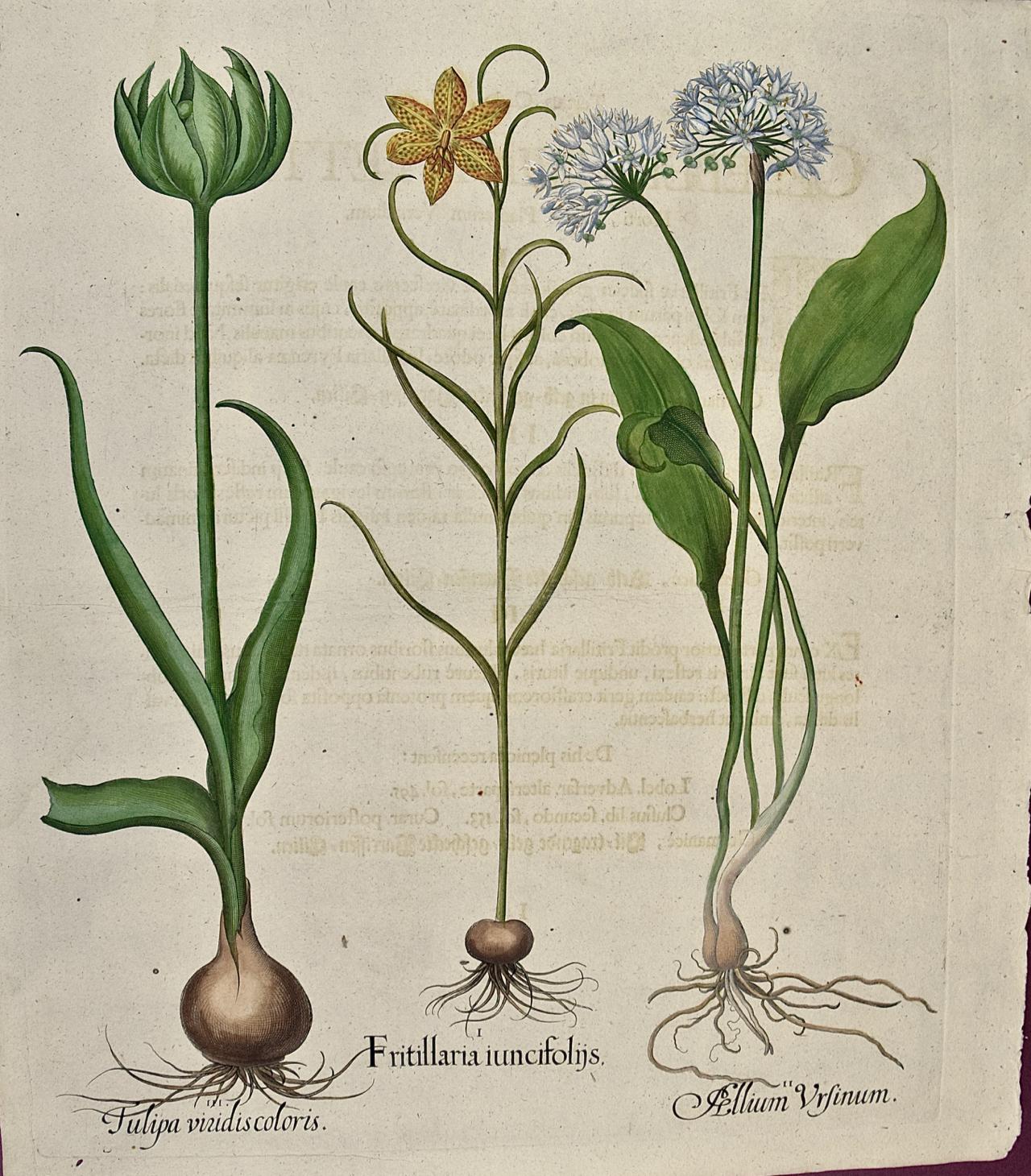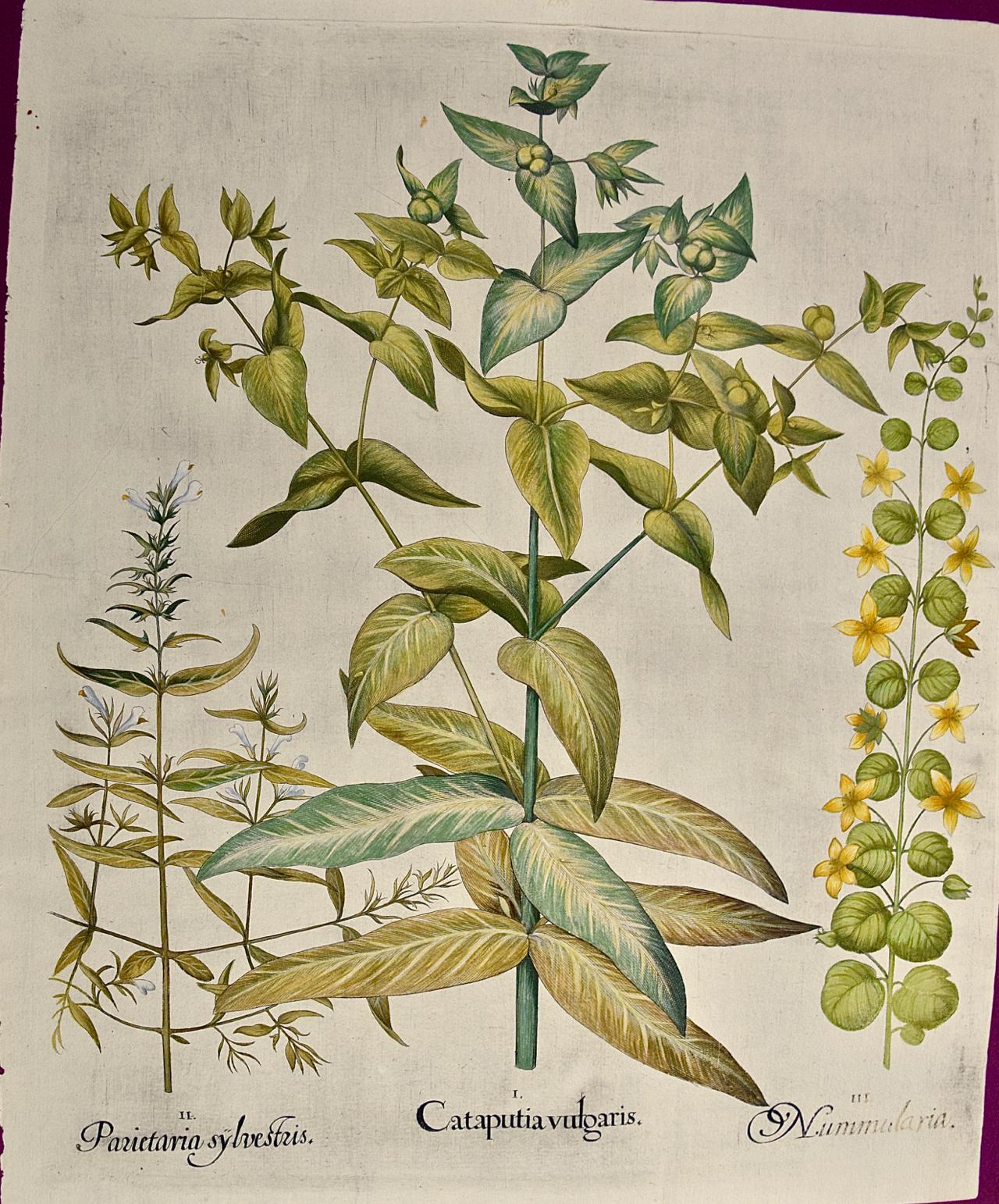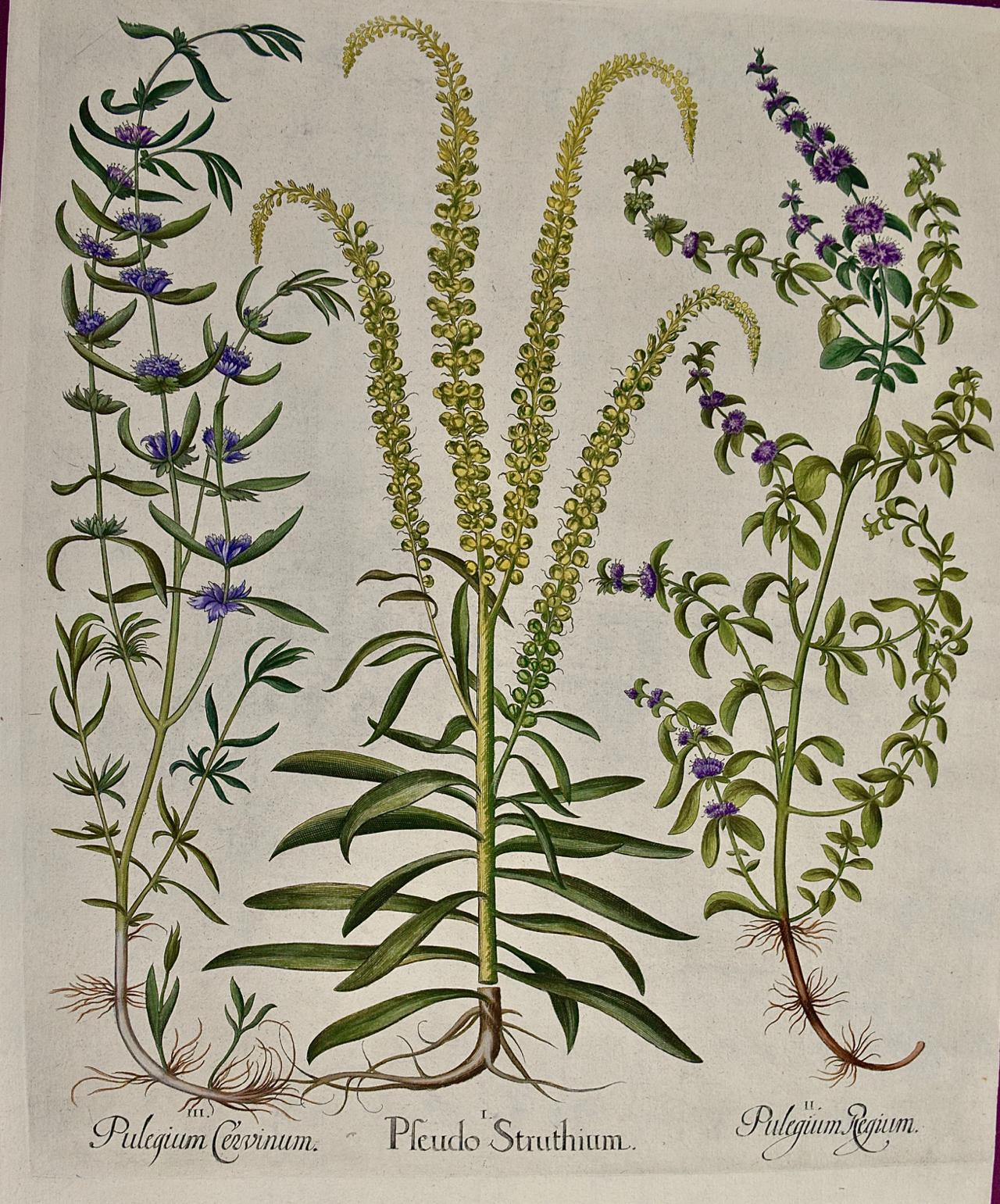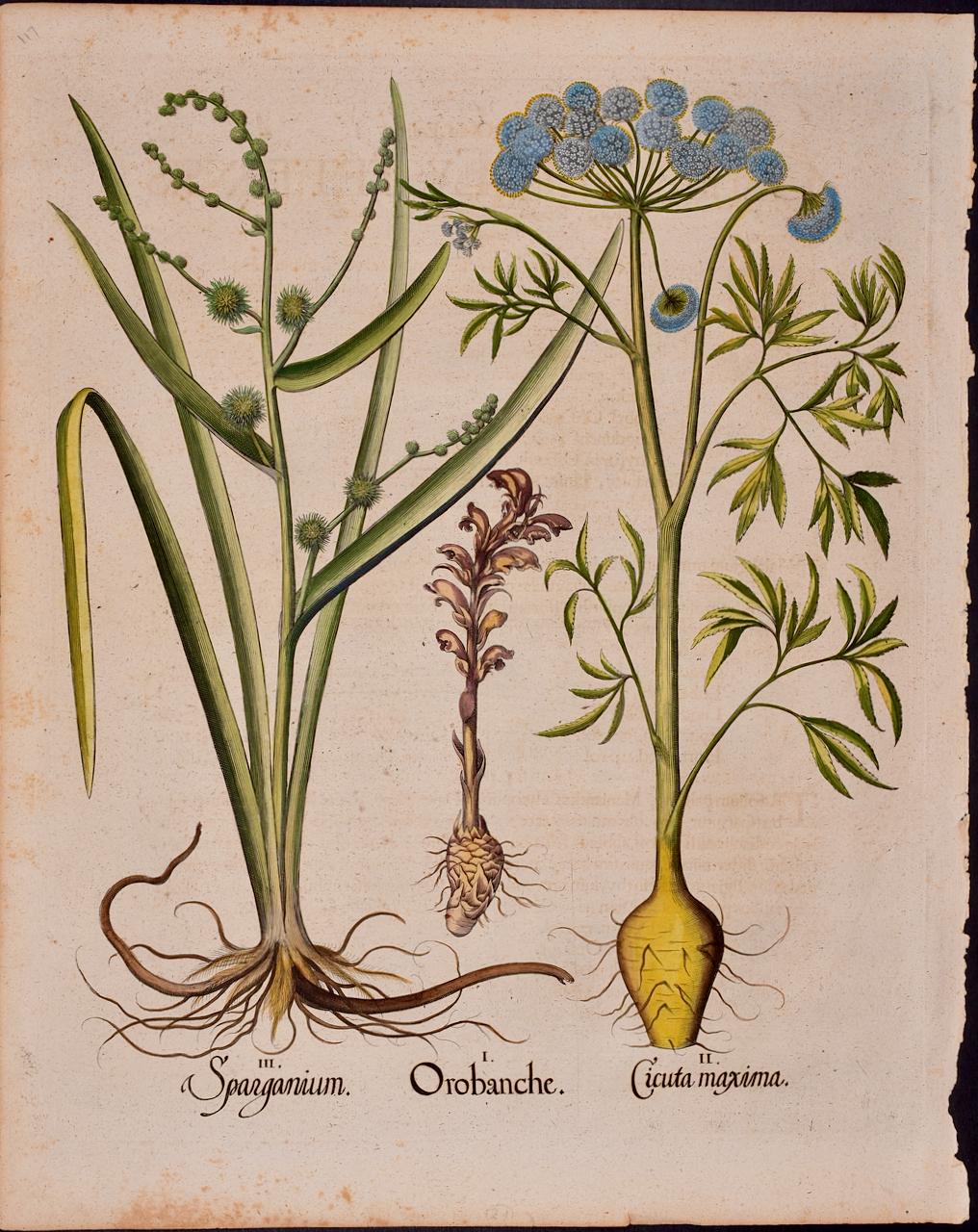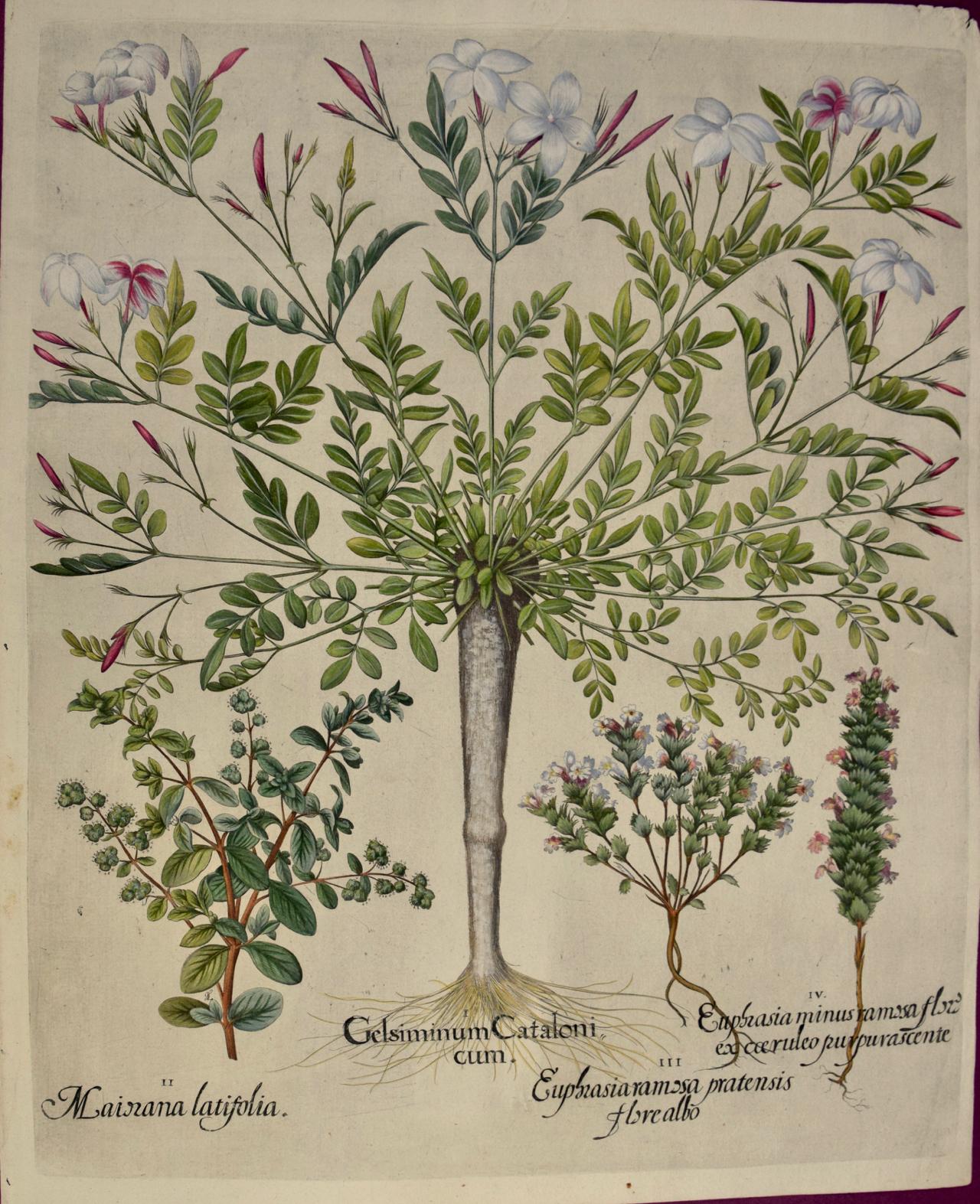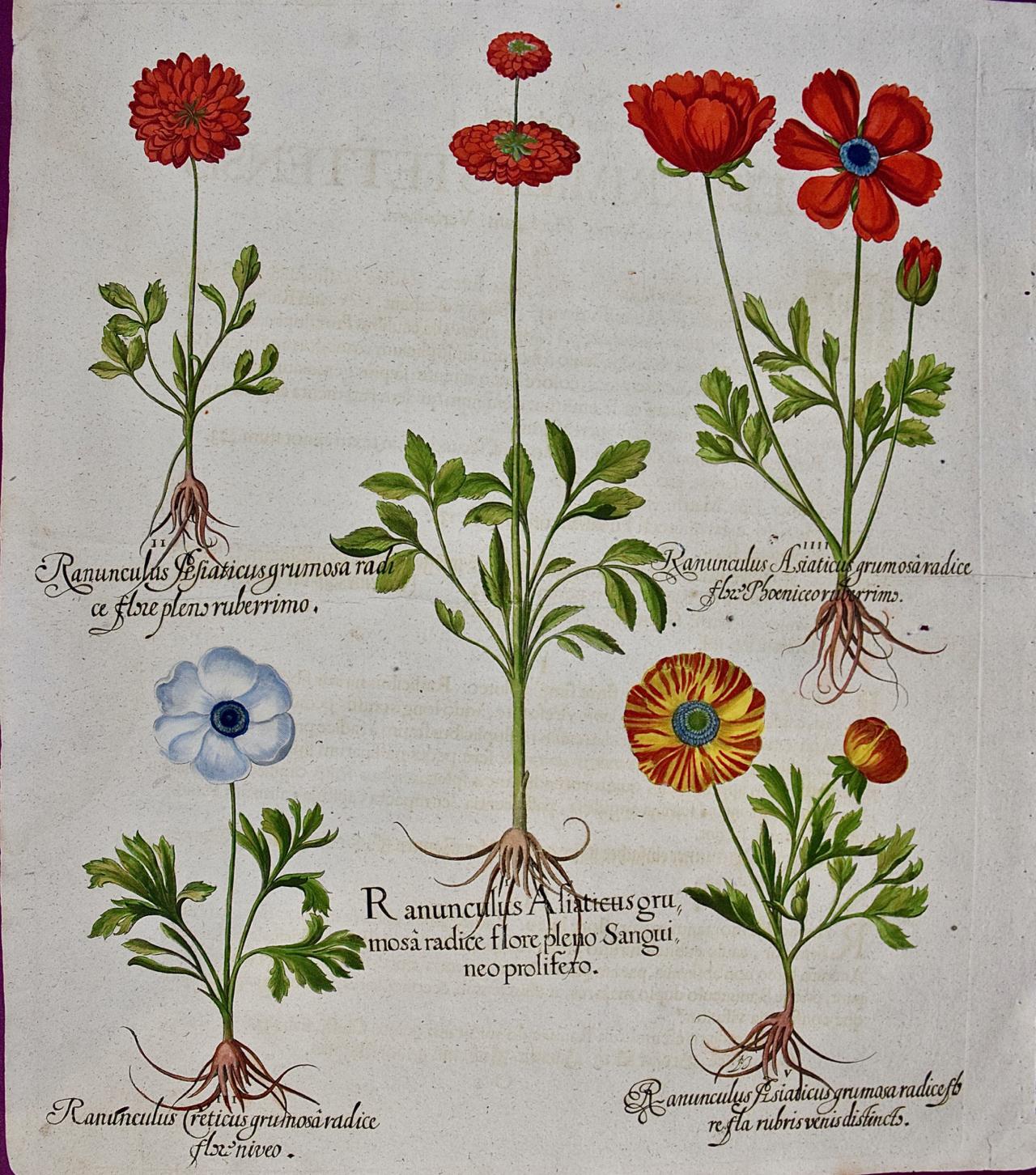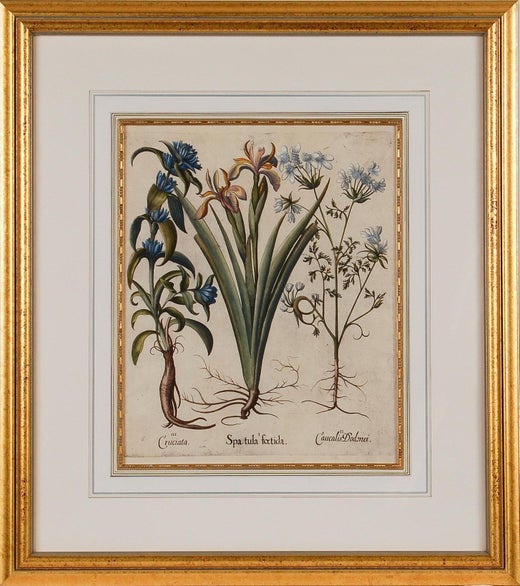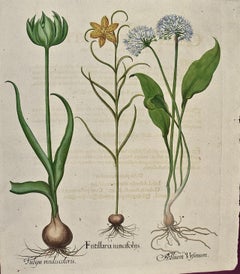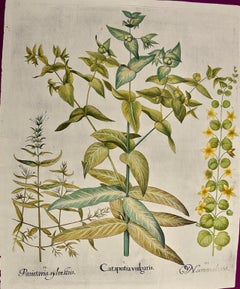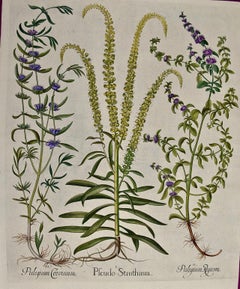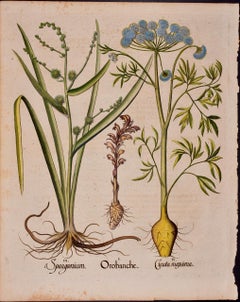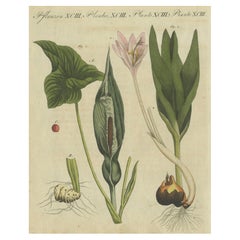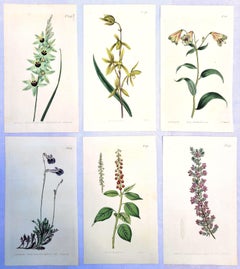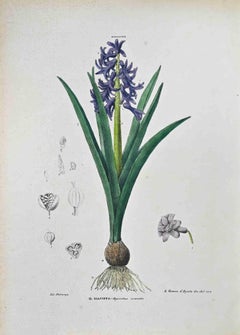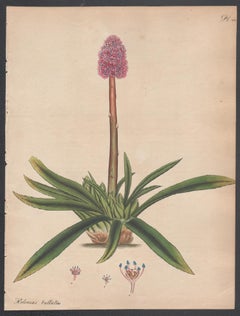Items Similar to Flowering Hyacinth & Calla Plants: A Besler Hand-colored Botanical Engraving
Want more images or videos?
Request additional images or videos from the seller
1 of 11
Basilius BeslerFlowering Hyacinth & Calla Plants: A Besler Hand-colored Botanical Engraving1713
1713
$3,375
£2,547.02
€2,915.95
CA$4,759.87
A$5,225.74
CHF 2,726.28
MX$63,238.76
NOK 34,169.70
SEK 32,196.84
DKK 21,766.81
About the Item
This is a hand-colored copper plate engraving depicting flowering "Hyacinthus Comosus Spurius" (Hyacinth), "Hyacinthus Anglicus" (Blue Hyacinth), "Palma Christi Maculata" (Castor Oil Plant), "Dracunculus Aquatilis" (Marsh Calla) plants from Basilius Besler's landmark work, Hortus Eystettensis (Garden at Eichstatt), first published in 1613 in Eichstatt, Germany near Nuremberg and later in 1640 and 1713.
This beautiful colorful engraving is printed on thick laid chain-linked paper. There is latin text on the verso. There is pinpoint hole in the periphery on the right and a horizontal crease centrally, related to the process of drying the paper during its production, which is common with original Besler engravings. The print is otherwise in excellent condition.
Basilius Besler (1561–1629) was an apothecary and botanist. He was curator of the Willibaldsburg Castle garden of Johann Konrad von Gemmingen, prince bishop of Eichstätt, in Bavaria, who supported Besler's academic and artistic creation and whose funds allowed the purchase of exotic plants from all over Europe. Besler spent 16 years producing drawings of 1084 varieties of plants and flowers in different seasons. These were then engraved on copper plates by master artists, resulting in the 367 beautiful and detailed engravings which comprise Besler's monumental florilegium Hortus Eystettensis, the first large-scale botanical publication.
- Creator:Basilius Besler
- Creation Year:1713
- Dimensions:Height: 20 in (50.8 cm)Width: 17.5 in (44.45 cm)
- Medium:
- Movement & Style:
- Period:
- Framing:Framing Options Available
- Condition:
- Gallery Location:Alamo, CA
- Reference Number:Seller: # 45211stDibs: LU117327876772
Basilius Besler (1561–1629) was an apothecary and botanist. He was curator of the Willibaldsburg Castle garden of Johann Konrad von Gemmingen, prince bishop of Eichstätt, in Bavaria, who supported Besler's academic and artistic creation and whose funds allowed the purchase of exotic plants from all over Europe. Besler spent 16 years producing drawings of 1084 varieties of plants and flowers in different seasons. These were then engraved on copper plates by master artists, resulting in the 367 beautiful and detailed engravings which comprise Besler's monumental florilegium Hortus Eystettensis, the first large-scale botanical publication.
About the Seller
5.0
Gold Seller
Premium sellers maintaining a 4.3+ rating and 24-hour response times
Established in 2011
1stDibs seller since 2019
292 sales on 1stDibs
Typical response time: 1 hour
- ShippingRetrieving quote...Shipping from: Alamo, CA
- Return Policy
Authenticity Guarantee
In the unlikely event there’s an issue with an item’s authenticity, contact us within 1 year for a full refund. DetailsMoney-Back Guarantee
If your item is not as described, is damaged in transit, or does not arrive, contact us within 7 days for a full refund. Details24-Hour Cancellation
You have a 24-hour grace period in which to reconsider your purchase, with no questions asked.Vetted Professional Sellers
Our world-class sellers must adhere to strict standards for service and quality, maintaining the integrity of our listings.Price-Match Guarantee
If you find that a seller listed the same item for a lower price elsewhere, we’ll match it.Trusted Global Delivery
Our best-in-class carrier network provides specialized shipping options worldwide, including custom delivery.More From This Seller
View AllBesler Hand-colored Botanical Engraving of Flowering Tulip & Wild Garlic Plants
Located in Alamo, CA
This is a hand-colored copperplate engraving entitled "Tulipa viridiscoloris, Fritillaria iuncifolns, Allium Vrsinum" depicting flowering tulip, fritillary and wild garlic plants fro...
Category
Early 18th Century Academic Still-life Prints
Materials
Engraving
Flowering Lily Plants: A 17th C. Besler Hand-colored Botanical Engraving
Located in Alamo, CA
This is a hand-colored copper plate engraving entitled "Cataputia Vulgaris, Parietaria Sylvestris, Nummularia", depicting flowering Spanish Nut, Yellow Turk's-cap Lily, Yellow Turk's...
Category
1640s Academic Still-life Prints
Materials
Engraving
Flowering Peppermint Plants: A 17th C. Besler Hand-colored Botanical Engraving
Located in Alamo, CA
This is a hand-colored copper plate engraving entitled "Pulegium Cervinum, Pseudo Pulegium Struthium, Pulegium Regium", depicting flowering Peppermint, Weld and Pennyroyal plants respectively from Basilius Besler's landmark work, Hortus Eystettensis (Garden at Eichstatt), first published in 1613 in Eichstatt, Germany near Nuremberg and later in 1640 and 1713.
This beautiful colorful engraving is printed on thin laid chain-linked paper. There are subtle creases in the right upper corner, very common with Besler's relating to the drying of the paper during its production. The right margin is thinner than the others. The print is otherwise in excellent condition with striking hand-coloring.
Basilius Besler (1561–1629) was an apothecary and botanist. He was curator of the Willibaldsburg Castle garden of Johann Konrad von Gemmingen, prince bishop...
Category
1640s Academic Still-life Prints
Materials
Engraving
Bur Reed & Water Hemlock: A 17th-18th C. Besler Hand-colored Botanical Engraving
Located in Alamo, CA
This is a hand-colored copper plate engraving entitled "Orobanche, Cicuta Maxima, Sparganium (Bur Reed, Water Hemlock, Broomrape) ", depicting a flowering Bur Reed, Water Hemlock, Broomrape plants from Basilius Besler's landmark work, Hortus Eystettensis (Garden at Eichstatt), first published in 1613 in Eichstatt, Germany near Nuremberg and later in 1640 and 1713.
This beautiful colorful engraving is printed on thin laid chain-linked paper with wide margins. There us spotting and some discoloration, most prominently in the upper and lower margins. There is irregularity and some loss along the right paper edge. The print is otherwise in excellent condition with striking hand-coloring. The sheet measures 21.5" high and 17.25" wide.
Basilius Besler (1561–1629) was an apothecary and botanist. He was curator of the Willibaldsburg Castle garden of Johann Konrad von Gemmingen, prince bishop...
Category
Early 18th Century Academic Still-life Prints
Materials
Engraving
Flowering Jasmine and Laurel Plants: A Besler Hand-colored Botanical Engraving
Located in Alamo, CA
This is a hand-colored copper-plate engraving entitled "Gelsiminum Catalonicum, Mairana Latifollia, Euphasiaramosa Pratensis Flore Albo, Euphasia Minus Ramosa Flore Excereruleo Purpurascente", depicting flowering Jasmine, Mountain Laurel...
Category
1710s Academic Still-life Prints
Materials
Engraving
Buttercup Flowers: A Besler 18th Century Hand-colored Botanical Engraving
Located in Alamo, CA
This is a hand-colored copper plate engraving depicting Ranunculus (Persian Buttercup) flowers from Basilius Besler's landmark work, Hortus Eystettensis (Garden at Eichstatt), first published in 1613 in Eichstatt, Germany near Nuremberg and later in 1640 and 1713.
This beautiful colorful engraving is printed on thick laid chain-linked paper. There is latin text on the verso. There are central horizontal creases and two small holes on the right and another in the left lower corner. It is otherwise in excellent condition.
Basilius Besler (1561–1629) was an apothecary and botanist. He was curator of the Willibaldsburg Castle garden of Johann Konrad von Gemmingen, prince bishop...
Category
Early 18th Century Academic Still-life Prints
Materials
Engraving
You May Also Like
Elegant 1805 Hand-Colored Botanical Engraving of Bulbous Plants from Bertuch
Located in Langweer, NL
Title: Elegant 1805 Hand-Colored Botanical Engraving of Bulbous Plants from Bertuch
Description:
This detailed hand-colored botanical engraving is taken from Friedrich Justin Be...
Category
Antique Early 1800s Prints
Materials
Paper
Set of Six Hand-Colored Engravings from Curtis's Botanical Magazine /// Botany
By William Curtis
Located in Saint Augustine, FL
Artist: William Curtis (English, 1746-1799)
Title: Set of Six Hand-Colored Engravings
Portfolio: The Botanical Magazine; or, Flower-Garden Displayed
Year: 1800-1815 (First-second ser...
Category
Early 1800s Victorian Still-life Prints
Materials
Watercolor, Engraving, Intaglio
The Hyacinth - Lithograph by Vincenzo Tenore - 1870s
Located in Roma, IT
Lithograph hand watercolored.
Plate from "Atlante di Botanica popolare ossia Illustrazione di Piante Notevoli di ogni famiglia" (Atlas of popular botany or illustration of notable p...
Category
1870s Modern Figurative Prints
Materials
Lithograph
Spear-leaved Helonias, Henry Andrews antique botanical flower engraving print
By Henry C Andrews
Located in Melbourne, Victoria
'Helonias bullata - Spear-leaved Helonias'
Native of Carolina, North America.
Original copper-line engraving with original hand-colouring from Henry Andrews' 'The Botanist's Repos...
Category
Early 19th Century Naturalistic Still-life Prints
Materials
Engraving
Northian Moraea. Henry Andrews antique botanical flower engraving print
By Henry C Andrews
Located in Melbourne, Victoria
'Morea Northiana - Northian Moraea'
'Native of the Brazils'.
Original copper-line engraving with original hand-colouring from Henry Andrews' 'The Botanist's Repository', 1797-1812...
Category
Early 19th Century Naturalistic Still-life Prints
Materials
Engraving
Streptanthera cuprea, antique botanical flower engraving
Located in Melbourne, Victoria
Engraving with original hand-colouring. 1834. 230mm by 155mm. From Paxton's 'Magazine of botany and register of flowering plants' by Sir Joseph Paxton.
Category
Mid-19th Century Naturalistic More Prints
Materials
Engraving
More Ways To Browse
Antique Engraving Plates
18th Century Colored Engraving
Copper Engraving Plate
Hand Colored Botanical
18th Century Botanicals
Hand Colored Copper Engraving
Hand Colored Botanical Prints
18th Century Botanical Prints
Abstract Reclining Sculpture
Agustin Cardenas
Anne De Villemejane
Astronaut Sculpture
Bamboo Pen
Bill Hemmerling
Blue Dog Original
Boy Horse
Brandon V Lewis
Bronze Of Ballet Dancers
